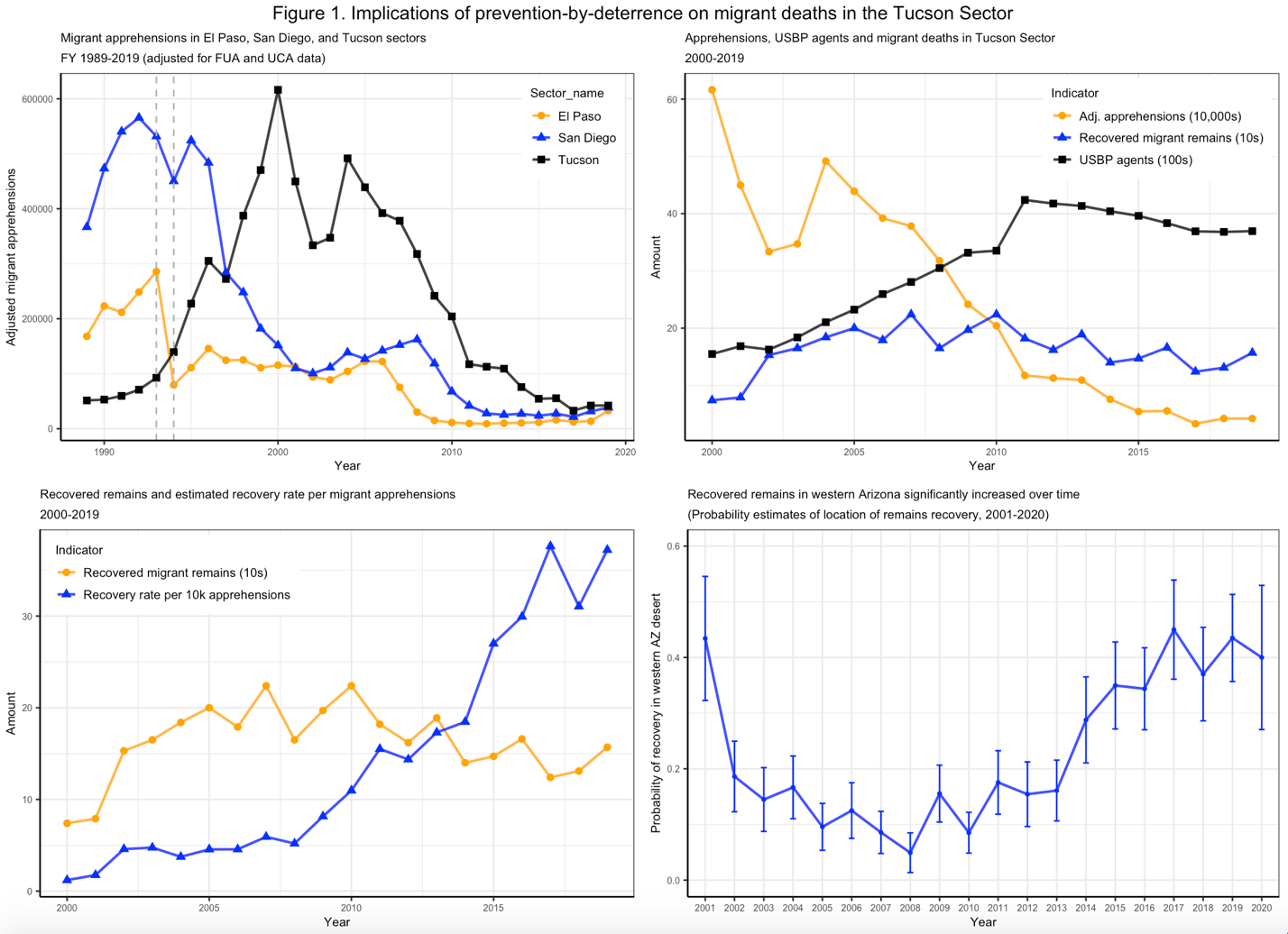Prevention-by-Deterrence Policies Have Counterintuitive Relationship to Migrant Death Crisis
By Bradford Jones
The Facts:
The U.S. Border Patrol’s policy of prevention-by-deterrence, implemented in the mid-1990s, created a “funnel effect” whereby unauthorized migrants attempted entry into more dangerous regions of the U.S.-Mexico border, particularly Arizona. This led to an increase in migrant deaths.
Despite increases in USBP presence in the Tucson Sector, coupled with a downturn in the number of migrants entering, deaths remain high and are counterintuitively related to deterrence policies. The reason for this has to do with changes in crossing behavior.
The Data:
With respect to the first fact, by the mid 1990s, most unauthorized crossings occurred in the El Paso and San Diego Sectors. To decrease migrant traffic in these sectors, the USBP implemented Operations Hold-the-Line (El Paso) and Gatekeeper (San Diego). The reasoning was if traffic was stopped here, unauthorized crossing would be curtailed because migrants would have to make a longer and more dangerous trek to enter. Thus, the policy of “prevention-by-deterrence” was ushered in, the concept being that if unauthorized migration could be made so difficult, migrants would not enter.
Instead, a “funnel effect” was created such that migrants started crossing through the Tucson Sector. The top left plot in Figure 1 shows the number of adjusted migrant apprehensions reported by the USBP in the El Paso, San Diego, and Tucson sectors from 1989 to 2019. The apprehensions data are “adjusted” by removing apprehensions of unaccompanied children (UCAs) and family unit apprehensions (FUAs) from the totals. UCAs and FUAs are mostly asylum seekers and are therefore presenting themselves at the border for apprehension. The adjusted number is a more accurate estimate of migrant crossers.

The vertical dashed lines denote 1993 (Hold-the-Line) and 1994 (Gatekeeper). In general, migrant apprehensions significantly drop in these two sectors before and after implementation. But due to the funnel effect, the Tucson Sector saw a massive increase in apprehensions.
Increased flows into the Tucson Sector created a migrant death crisis, the issue raised in the second fact. To understand this, consider the upper right panel in Figure 1, which gives apprehension statistics (in 10,000s), USBP staffing (in 100s), and migrant recovered remains (in 10s) from 2000 to 2019. Three points emerge.
First, although migrant apprehensions in the Tucson Sector remain high, over time, the number decreases. Second, if total apprehensions is a proxy for the volume of migrants crossing, then even as the number of likely crossers decreases, resources devoted to enforcement increases, as indicated by the number of USBP agents assigned to the Tucson Sector.
Third, migrant death totals, remain flat, counterintuitively related to crossing volume as well as USBP presence. The correlation between recovered remains and apprehensions is negative (r=-0.10) implying that as crossing volume decreased, migrant deaths increased. Additionally, increased immigration enforcement had no effect on decreasing migrant deaths. The correlation between USBP staffing and migrant deaths is positive (r=0.26), implying increases in USBP presence was related to increases in migrant deaths.
The lower left panel in Figure 1 shows the approximate death rate (blue line). These estimates show the ratio of the number of remains recovered per 10,000 apprehensions. The death rate is generally increasing over time implying that as crossing volume decreased, migrant deaths increased.
What can account for this? Increased enforcement measures in the Tucson Sector likely led to greater risk-taking among migrants. In Arizona, this implies migrants increasingly entered through the western desert, a more remote and dangerous region.
The bottom right panel of Figure 1 gives the per-year estimate of the probability a migrant’s remains were found in the western desert based on a statistical model using information on the location where remains were found. Over time, this probability increases, providing some evidence migrants were taking greater risks.
What does this mean for public policy?
Migrant crossings are at historically low levels. Apprehensions of crossers are at levels not seen since the early 1970s. With respect to deterrence policy aimed at migrant crossers, these data raise several questions.
- Are resources solely aimed at deterrence warranted given the absence of a material problem associated with crossings?
- Since increased deterrence is associated with increased risk-taking, are efforts solely aimed at entry restriction justifiable given the connection between them and a continuing migrant death crisis?
- Would increasing the number of available visas/work permits for economic migrants reduce the incentive to cross extralegally?
Given realities of the border and of border crossing, the trade-offs between the billions of dollars needed to construct a wall versus other demonstrable needs seem indefensible. Further, if ramped-up enforcement helps contribute to a migrant death crisis, then rethinking the “prevention-by-deterrence” model is necessary and long overdue.
